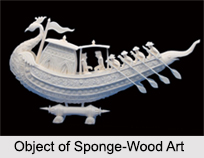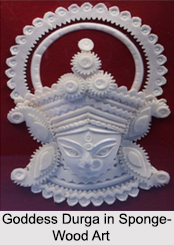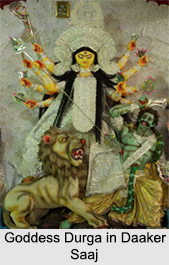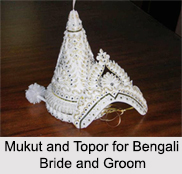 Sponge-wood is an aquatic plant, which is used to make various exquisite designs for ornamental purposes. Sponge-wood art is one of the most popular folk arts of West Bengal. The artistry of sponge-wood was first introduced by the Malakar community of Bengal, who were primarily considered to be the masters in the art of floral decoration. They are also known to be the experts in stringing garlands of sponge-wood. Some of the notable books like Vidyasundar, Chaitanya Charitamrita and Manasamangal have mentioned the subtle artistry of the Malakar community. The sponge-wood art or thermocol art is one of the most popular arts to be used in different decoration purposes; it if often even used instead of flowers.
Sponge-wood is an aquatic plant, which is used to make various exquisite designs for ornamental purposes. Sponge-wood art is one of the most popular folk arts of West Bengal. The artistry of sponge-wood was first introduced by the Malakar community of Bengal, who were primarily considered to be the masters in the art of floral decoration. They are also known to be the experts in stringing garlands of sponge-wood. Some of the notable books like Vidyasundar, Chaitanya Charitamrita and Manasamangal have mentioned the subtle artistry of the Malakar community. The sponge-wood art or thermocol art is one of the most popular arts to be used in different decoration purposes; it if often even used instead of flowers.
Sponge-Wood Plant
Sponge-wood is an aquatic plant, which grows on its own in the wetlands of Bengal`s villages.
The plant is greenish in colour at the initial stage, and then it starts to become a thin or thick stick as it gradually develops. The thickness or thinness of the plant depends on the soil on which it is growing; though both of them are used to produce various objects. The plants are plucked from the water and then dried up to peel off the skin to get the white stalk of sponge-wood, which would be used by the sponge-wood artists.
 Ingredients to Produce Sponge-Wood Crafts
Ingredients to Produce Sponge-Wood Crafts
The ingredients, which are needed to produce sponge-wood crafts, are dried up sponge-wood plants, sharp knives and some gum. Earlier, paste of tamarind seeds was used instead of glue. The knives of this work are called "kath" and they are shaped according to the requirements. Different shaped knives are known by different names, like dhosa, kalso and istiri. Sponge-wood, when cut in different shapes, is known with different names; for example, circular shape is called kups and string shape is called paturi. Then the kups and paturi are joined together by glue to create something new using artistic skills and bright colours. Procedure of creating sponge-wood crafts is quite different from any other forms of folk art.
Sponge-Wood Objects
There are various objects made of sponge-wood on the basis of the purpose. For example, sponge-wood objects for social functions and ceremonies are flowers and garlands, lotus, swan, conch shell, garland with leafy decoration, kadamba flower for the Rash festival, topor and sinthi mour (headdresses worn respectively by the bridegroom and the bride during a marriage ceremony), square frames fixed above the ghofs of popular deities etc.
Certain sponge-wood objects are also produced for the offerings to the Gods at holy places. For example, Malakar artists of Howrah District make sponge-wood boats to offer at temples and sponge-wood horses to offer at the hermitage of Muslim saints. In North Bengal, particularly in the districts of Jalpaiguri and Cooch Behar, sponge-wood is used to make idols and portraits of Goddess Manasa, which are called karandia and also for making masks of Goddess Kali. In Medinipur District, beautiful temples of sponge-wood are produced to place them on the rafts, which are made of banana tree stalks to float them on ponds for the sake of peace for the resting souls during their funerals.
 Sponge-wood is also used for ornamental decorations and the objects include flowers like kadamba, lotus and water-lily; garlands of tuberoses; thick wreaths; many varieties of leafy decorations; decorative crowns and ornaments for idols. The most popular sponge-wood art named "daaker saaj" is produced by the sponge-wood artists of Bardhaman and Nadia districts. "Daaker saaj" is used to adorn the grand idols of Hindu goddesses.
Sponge-wood is also used for ornamental decorations and the objects include flowers like kadamba, lotus and water-lily; garlands of tuberoses; thick wreaths; many varieties of leafy decorations; decorative crowns and ornaments for idols. The most popular sponge-wood art named "daaker saaj" is produced by the sponge-wood artists of Bardhaman and Nadia districts. "Daaker saaj" is used to adorn the grand idols of Hindu goddesses.
Some of the other sponge-wood objects are trees, creepers, birds, animals, banana trees, Taj Mahal, peacock-shaped boats, jhankpakhis etc. Jhankpakhis are hung above the head of a child lying on bed. The shelves of it are round and sparrows of sponge-wood are attached to it.
 Settlement of Sponge-Wood Artists
Settlement of Sponge-Wood Artists
The sponge-wood or Malakar artists have settled in various parts of West Bengal mostly in Howrah, Hoogly, Purulia, Medinipur, Bankura, North and South 24 Parganas, Nadia, Bardhaman, Murshidabad and Birbhum District. In Kolkata certain areas are famous for this artistry and they are Natunbazar, Kumortuli and Bagbazar. After the 1947 partition, several artists of Malakar community of East Bengal migrated to West Bengal and most of them are now residing in Cooch Behar and Jalpaiguri districts of the state.



















